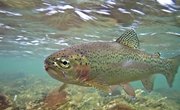
Many different species of bacteria thrive on uncooked meat and vegetables; contamination by these microscopic organisms can lead to food poisoning, with effects ranging from diarrhea and vomiting to cramps and chills. Most food poisoning passes in a few days, but some cases can be more serious, especially for children, the elderly or people with weakened immune systems. A number of different bacterial agents can cause food poisoning, but it's relatively simple to kill or avoid most of them.
Bacteria in Meat
Raw meat such as beef, pork or lamb can contain a range of different bacterial pathogens, including salmonella, campylobacter jejuni, clostridium perfringens and E. coli. To eliminate these threats, freeze or refrigerate meat as soon as possible after purchasing it. Cook meat to the recommended safe temperature and allow it to rest for the recommended length of time. For instance, cook fresh pork to 145 degrees, then allow it to rest for 3 minutes before eating.
You should also eat or refrigerate meat promptly after cooking. Some bacteria, such as C. perfringens, can breed in cooked food at room temperature.
Cross-contamination from meat to other food, such as uncooked fruit or vegetables, is a real danger. Always wash your hands before and after handling raw meat. In addition, wash countertops, cutting boards and utensils that come into contact with raw meat before using them for any other purpose. Better still, keep them separate, with different work surfaces for different types of food.
Bacteria in Poultry
Poultry, such as chicken, turkey and duck, can contain many of the same bacterial pathogens as meat. Although it might seem like a wise precaution, washing raw poultry before cooking is a bad idea -- it's more likely to result in splashing your kitchen with contaminated water than actually killing bacteria.
To prevent infection from campylobacter and other potentially-dangerous bacteria such as listeria, cook poultry to its minimum safe temperature. The Food and Drug Administration maintains a list of safe temperatures.
As with meat, always wash your hands before and after handling poultry and avoid cross-contamination with other foods by using separate utensils and chopping boards.
Bacteria in Fish
Seafood can carry many of the same pathogens as meat and poultry, as well as some that are specific to marine environments. Bacteria of the vibrio genus, for example, live in seawater and can contaminate fish, shellfish and other seafood. Fermented fish -- a traditional dish in places as diverse as Scandinavia, Cambodia and Egypt -- can carry clostridium botulinum, the bacteria that causes botulism.
Fish safety starts at the market. Always buy fish from a refrigerated case or a bed of fresh ice. Melted ice may be a sign that the fish has been at room temperature too long. Refrigerate or freeze seafood immediately, wash your hands before and after handling it, and cook it to the recommended safe temperature. Don't thaw frozen fish by leaving it at room temperature -- place it in the refrigerator overnight or seal it in a plastic bag and immerse it in cold water. You can also thaw it in a microwave as long as you cook it promptly afterward.
Bacteria on Vegetables
Fruits and vegetables aren't immune from the threat of bacterial contamination. In fact, many of the bacteria found on vegetables, such as staphylococcus aureus and shigella, come from humans.
To cut down on the danger of bacterial pathogens, check fruit for damaged or broken peel; the peel is the fruit's first line of defense against bacterial infection. Wash fruit and vegetables thoroughly, even if you're going to peel them before cooking or eating. Refrigerate vegetables within two hours if you've cooked them or cut the skin. At all stages of cooking, keep fruit and vegetables separate from raw meat, poultry or fish.
Non-Bacterial Pathogens
Many cases of food poisoning are caused by bacteria, but there are other threats as well. Undercooked meat can contain parasites, such as the larval worms found in undercooked pork that cause trichinosis. Norovirus -- a fast-spreading virus that causes vomiting, diarrhea, cramps and fever -- can spread through contaminated water, including ice. It's also found on shellfish, bread products and some vegetables.
References
- Food and Drug Administration: Top 14 Foodborne Pathogens
- Food Safety: Safe Minimum Cooking Temperatures
- Daily Telegraph: How to Prepare and Cook Chicken Safely
- Visit Sweden: Fermented Herring
- Food and Drug Administration: Fresh and Frozen Seafood - Selecting and Serving Safely
- Centers for Disease Control: Food Safety Basics for Fruits and Vegetables
- Medline Plus: Trichinosis
About the Author
Dr James Holloway has been writing about games, geek culture and whisky since 1995. A former editor of "Archaeological Review from Cambridge," he has also written for Fortean Times, Fantasy Flight Games and The Unspeakable Oath. A graduate of Cambridge University, Holloway runs the blog Gonzo History Gaming.
Photo Credits
Nick White/Photodisc/Getty Images
